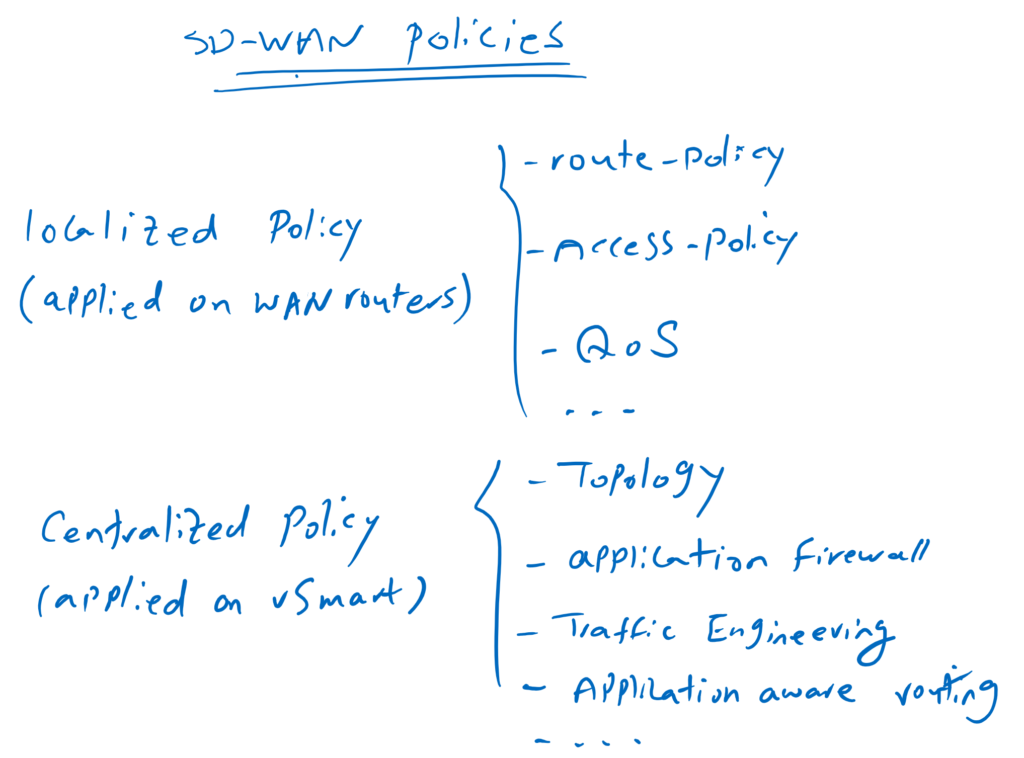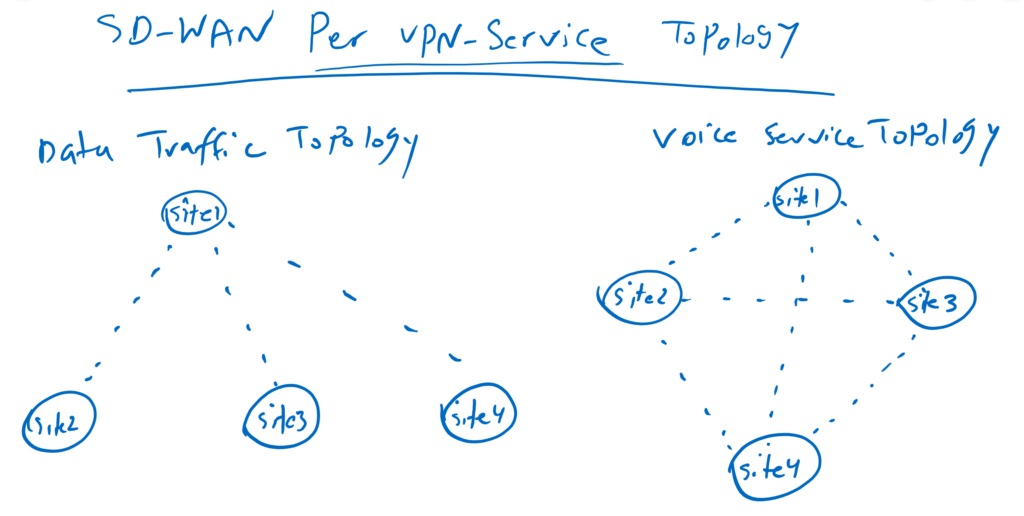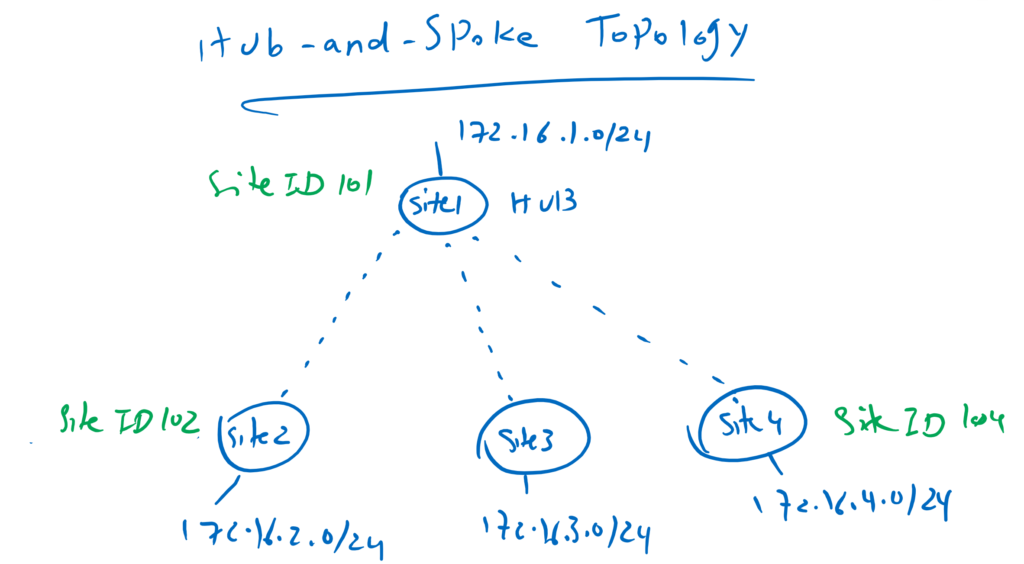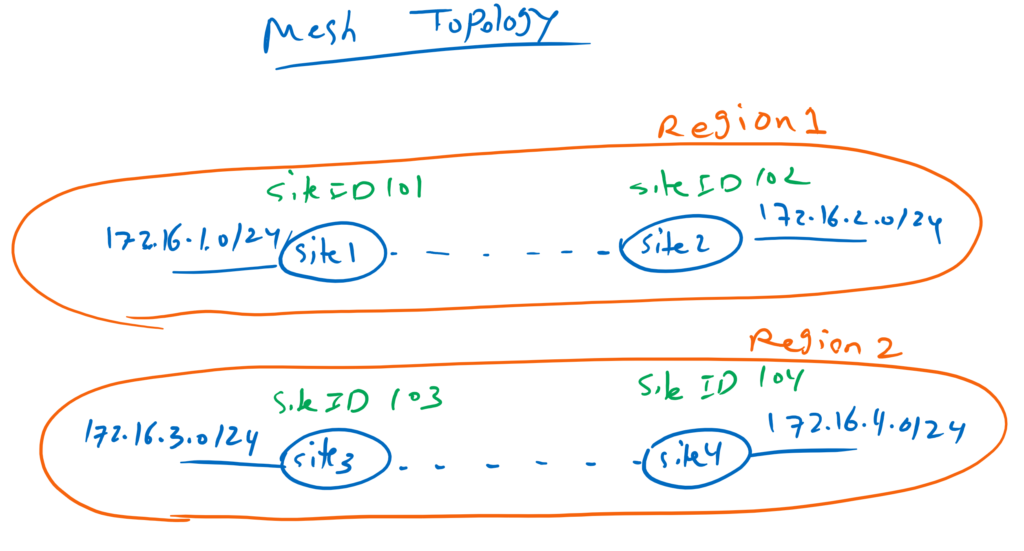Cisco SD-WAN Topology has a full-mesh topology by default. in other words all sites can communicate with each other without any limitation. In this section two other topologies, hub and spoke and mesh topology is implemented in cisco SD-WAN infrastructure.
Introduction to cisco SD-WAN Topology
Just to remind you, we have two types of policies in cisco SD-WAN infrastructure. localized policy that are applied directly to WAN routers and centralized policy that are applied to vSmart controller.
for topology change, centralized policy is used in cisco SD-WAN infrastructure. in other words, every topology change is implemented through the vSmart controller.
vSamrt controller can change the topology easily with filtering routes when advertising through OMP routing protocol or changing prefrence attribute.
What is interesting to me when I implement different topologies in Cisco SD-WAN infrastructure, is that, topologies can be implemented per VPN service. In other words, you can, for example, implement a hub-and-spoke topology for data traffic, but at the same time implement a full-mesh topology for voice traffic. It is not easy to implement such a topology in traditional solutions.
implement hub and spoke topology
check topology status before any changes
Hub-and-spoke topology is the first topology that we implement. Site1 with Site ID 101 is our hub site and other sites with Site ID 102 to 104 are spoke sites.
Before we change the topology, let’s make sure what the current topology is.
We connect to cEdge4 and then check the routing table with the command “show ip route vrf 10”.
cEdge4#show ip route vrf 10
Routing Table: 10
Codes: L - local, C - connected, S - static, R - RIP, M - mobile, B - BGP
D - EIGRP, EX - EIGRP external, O - OSPF, IA - OSPF inter area
N1 - OSPF NSSA external type 1, N2 - OSPF NSSA external type 2
E1 - OSPF external type 1, E2 - OSPF external type 2, m - OMP
n - NAT, Ni - NAT inside, No - NAT outside, Nd - NAT DIA
i - IS-IS, su - IS-IS summary, L1 - IS-IS level-1, L2 - IS-IS level-2
ia - IS-IS inter area, * - candidate default, U - per-user static route
H - NHRP, G - NHRP registered, g - NHRP registration summary
o - ODR, P - periodic downloaded static route, l - LISP
a - application route
+ - replicated route, % - next hop override, p - overrides from PfR
Gateway of last resort is not set
10.0.0.0/8 is variably subnetted, 3 subnets, 2 masks
m 10.1.0.1/32 [251/0] via 1.1.1.101, 00:32:45
m 10.1.1.0/24 [251/0] via 1.1.1.101, 00:32:45
m 10.1.2.0/24 [251/0] via 1.1.1.101, 00:32:45
172.16.0.0/16 is variably subnetted, 6 subnets, 2 masks
m 172.16.1.0/24 [251/0] via 1.1.1.101, 00:32:45
m 172.16.2.0/24 [251/0] via 1.1.1.102, 00:32:45
m 172.16.3.0/24 [251/0] via 1.1.1.103, 00:34:35
C 172.16.4.0/24 is directly connected, Loopback10
L 172.16.4.1/32 is directly connected, Loopback10
m 172.16.11.0/24 [251/0] via 1.1.1.101, 00:32:45As you can see, next hop address points to the system IP of destination site itself.
We can also check the connectivity with the traceroute command.
cEdge4#traceroute vrf 10 172.16.3.1 source 172.16.4.1
Type escape sequence to abort.
Tracing the route to 172.16.3.1
VRF info: (vrf in name/id, vrf out name/id)
1 172.16.3.1 2 msec 1 msec *
cEdge4#Since we have two transports between sites, the question is, which transport is used to route the traffic between sites. With the command “show sdwan omp route” we can check the OMP routing table with further details.
cEdge4#show sdwan omp routes
....
---------------------------------------------------
omp route entries for vpn 10 route 172.16.3.0/24
---------------------------------------------------
RECEIVED FROM:
peer 1.1.1.52
path-id 1
label 1001
status C,I,R
loss-reason not set
lost-to-peer not set
lost-to-path-id not set
Attributes:
originator 1.1.1.103
type installed
tloc 1.1.1.103, mpls, ipsec
ultimate-tloc not set
domain-id not set
overlay-id 1
site-id 103
preference not set
tag not set
origin-proto connected
origin-metric 0
as-path not set
unknown-attr-len not set
RECEIVED FROM:
peer 1.1.1.52
path-id 2
label 1001
status C,I,R
loss-reason not set
lost-to-peer not set
lost-to-path-id not set
Attributes:
originator 1.1.1.103
type installed
tloc 1.1.1.103, public-internet, ipsec
ultimate-tloc not set
domain-id not set
overlay-id 1
site-id 103
preference not set
tag not set
origin-proto connected
origin-metric 0
as-path not set
unknown-attr-len not set
....For example, if we check the detail for site3 (172.16.3.0/24), you can see that there are two paths with two tlocs in which traffic is routed. One through ipsec/mpls and the other through ipsec/internet. and both paths have the same preference. So we can expect the traffic to be shared between these two paths.
To make sure, we can also check it with command “show sdwan ip fib vpn 10”.
cEdge4#show sdwan ip fib vpn 10
NEXTHOP NEXTHOP NEXTHOP SA
VPN PREFIX IF NAME ADDR LABEL INDEX TLOC IP COLOR
------------------------------------------------------------------------------------------------------------------------------
10 10.1.0.1/32 ipsec 192.168.2.101 1001 17 1.1.1.101 mpls
10 10.1.0.1/32 ipsec 192.168.2.101 1001 18 1.1.1.101 mpls
10 10.1.0.1/32 ipsec 192.168.1.101 1001 19 1.1.1.101 public-internet
10 10.1.0.1/32 ipsec 192.168.1.101 1001 20 1.1.1.101 public-internet
10 10.1.1.0/24 ipsec 192.168.2.101 1001 17 1.1.1.101 mpls
10 10.1.1.0/24 ipsec 192.168.2.101 1001 18 1.1.1.101 mpls
10 10.1.1.0/24 ipsec 192.168.1.101 1001 19 1.1.1.101 public-internet
10 10.1.1.0/24 ipsec 192.168.1.101 1001 20 1.1.1.101 public-internet
10 10.1.2.0/24 ipsec 192.168.2.101 1001 17 1.1.1.101 mpls
10 10.1.2.0/24 ipsec 192.168.2.101 1001 18 1.1.1.101 mpls
10 10.1.2.0/24 ipsec 192.168.1.101 1001 19 1.1.1.101 public-internet
10 10.1.2.0/24 ipsec 192.168.1.101 1001 20 1.1.1.101 public-internet
10 172.16.1.0/24 ipsec 192.168.2.101 1001 17 1.1.1.101 mpls
10 172.16.1.0/24 ipsec 192.168.2.101 1001 18 1.1.1.101 mpls
10 172.16.1.0/24 ipsec 192.168.1.101 1001 19 1.1.1.101 public-internet
10 172.16.1.0/24 ipsec 192.168.1.101 1001 20 1.1.1.101 public-internet
10 172.16.2.0/24 ipsec 192.168.1.102 1001 21 1.1.1.102 public-internet
10 172.16.2.0/24 ipsec 192.168.1.102 1001 22 1.1.1.102 public-internet
10 172.16.2.0/24 ipsec 192.168.2.102 1001 23 1.1.1.102 mpls
10 172.16.2.0/24 ipsec 192.168.2.102 1001 24 1.1.1.102 mpls
10 172.16.3.0/24 ipsec 192.168.1.103 1001 13 1.1.1.103 public-internet
10 172.16.3.0/24 ipsec 192.168.1.103 1001 14 1.1.1.103 public-internet
10 172.16.3.0/24 ipsec 192.168.2.103 1001 15 1.1.1.103 mpls
10 172.16.3.0/24 ipsec 192.168.2.103 1001 16 1.1.1.103 mpls
10 172.16.11.0/24 ipsec 192.168.2.101 1001 17 1.1.1.101 mpls
10 172.16.11.0/24 ipsec 192.168.2.101 1001 18 1.1.1.101 mpls
10 172.16.11.0/24 ipsec 192.168.1.101 1001 19 1.1.1.101 public-internet
10 172.16.11.0/24 ipsec 192.168.1.101 1001 20 1.1.1.101 public-internet
As you can see there are four path to reach destination site3 (172.16.3.0/24). Two over public-internet transport and two over mpls transport. from mpls transport to internet transport, from internet to internet, from mpls to mpls and from internet to mpls transport.
configure hub and spoke topology
Now we can start changing topology for VPN10 service traffic. However, this is the only VPN service that we have implemented in our topology, but it is important to know that topology changes are possible per service VPN.
Topology changes are configured through a centralized policy. In other words, all configurations are implemented in vSmart controller. When vSamrt controller learns or advertises routes through OMP, it can control which routes to which sites are advertised with which preference.
First, let’s specify to vManage, which site is our hub site and which are spoke sites.
CONFIGURATION -> POLICIES -> centralized Policy -> custom options -> Site -> New Site List
Site List Name: HUB
Add Site: 101
CONFIGURATION -> POLICIES -> centralized Policy -> custom options -> Site -> New Site List
Site List Name: SPOKES
Add Site: 102-104Then we specify service VPN number in which we change the topology.
CONFIGURATION -> POLICIES -> centralized Policy -> custom options -> VPN -> New VPN List
VPN List Name: VPN10
Add VPN: 10Then we specify our interesting topology.
CONFIGURATION -> POLICIES -> centralized Policy -> custom options -> topology -> Add Topology -> Hub-and-Spoke
Name: Hub-and-Spoke
Description: Hub-and-Spoke
VPN List: VPN10 (defined above)
Add Hub Site: Site List=HUB (defined above)
Add Spoke Sites: Site List= SPOKES (defined above)Now we have to specify a container policy. As in the previous section explained. Container policy is just a container for policies of any type. Container policy is required, since it is the only policy that can be applied to vSamrt controller.
We create a new one with the name of vSamrt_Policy since this policy must be applied to vSamrt controller.
CONFIGURATION -> POLICIES -> centralized Policy -> Add Policy -> section: Configure Topology and VPN Membership
Policy Name: vSmart_Policy
Policy Description : vSmart_Policy
Import : Hub-and-SpokeWith preview, we can check the configuration that will be applied to vSmart controller.
viptela-policy:policy
control-policy control_2008914673
sequence 10
match route
site-list HUB
vpn-list VN10
!
action accept
!
!
sequence 20
match tloc
site-list HUB
!
action accept
!
!
default-action reject
!
lists
site-list HUB
site-id 101
!
site-list SPOKES
site-id 102-104
!
vpn-list VN10
vpn 10
!
!
!
apply-policy
site-list SPOKES
control-policy control_2008914673 outAs we can see in the output command, the policy is applied only when routes are advertised to spokes thorugh vSamrt controller. The policy states that routes will only be advertised to spoke routers if they belong to the hub site and VPN10 service VPN. This is also true for tloc routes. Tloc routes are only advertised to spoke sites if they belong to Hub-Site. The other routes are rejected by default.
With this policy, spoke sites can not communicate to each other and the communication only with hub site is only possible.
Next we have to activate our policy as follows.
Again we can check vrf 10 routing table in cEdge4 with “show ip route vrf 10”. As we expect, there is no more any routes in cEdge4 router except the routes belonging to hub site.
cEdge4#show ip route vrf 10
Routing Table: 10
Codes: L - local, C - connected, S - static, R - RIP, M - mobile, B - BGP
D - EIGRP, EX - EIGRP external, O - OSPF, IA - OSPF inter area
N1 - OSPF NSSA external type 1, N2 - OSPF NSSA external type 2
E1 - OSPF external type 1, E2 - OSPF external type 2, m - OMP
n - NAT, Ni - NAT inside, No - NAT outside, Nd - NAT DIA
i - IS-IS, su - IS-IS summary, L1 - IS-IS level-1, L2 - IS-IS level-2
ia - IS-IS inter area, * - candidate default, U - per-user static route
H - NHRP, G - NHRP registered, g - NHRP registration summary
o - ODR, P - periodic downloaded static route, l - LISP
a - application route
+ - replicated route, % - next hop override, p - overrides from PfR
Gateway of last resort is not set
10.0.0.0/8 is variably subnetted, 3 subnets, 2 masks
m 10.1.0.1/32 [251/0] via 1.1.1.101, 07:10:11
m 10.1.1.0/24 [251/0] via 1.1.1.101, 07:10:11
m 10.1.2.0/24 [251/0] via 1.1.1.101, 07:10:11
172.16.0.0/16 is variably subnetted, 4 subnets, 2 masks
m 172.16.1.0/24 [251/0] via 1.1.1.101, 07:10:11
C 172.16.4.0/24 is directly connected, Loopback10
L 172.16.4.1/32 is directly connected, Loopback10
m 172.16.11.0/24 [251/0] via 1.1.1.101, 07:10:11
cEdge4#So the communication will not be possible any more between spoke sites. But with hub , the communication is still possible.
cEdge4#traceroute vrf 10 172.16.3.1 source 172.16.4.1
Type escape sequence to abort.
Tracing the route to 172.16.3.1
VRF info: (vrf in name/id, vrf out name/id)
1 * * *
2 * * *
3
cEdge4#
cEdge4#traceroute vrf 10 172.16.1.1 source 172.16.4.1
Type escape sequence to abort.
Tracing the route to 172.16.1.1
VRF info: (vrf in name/id, vrf out name/id)
1 172.16.1.1 462 msec * 5 msec
cEdge4#configure WAN Transport Prefrence
Still, there are two questions in this topology. First, how can I prefer mpls transport to internet transport for the communication between sites.. Second, how spoke sites can communicate to each other, but through hub site and not directly.
To answer these two questions, lets’ edit our policy. First, we need to differentiate between mpls and internet transport by setting the tloc preference. we set preference 200 for mpls tloc and preference 150 for internet tloc.
CONFIGURATION -> POLICIES -> centralized Policy -> custom options -> TLOC -> New TLOC List
List Name: HUB_TLOC
TLOC IP: 1.1.1.101
Color: mpls
Encap: ipsec
Preference: 200
TLOC IP: 1.1.1.101
Color: public-internet
Encap: ipsec
Preference: 150Then we apply the new preference in our Hub-and-Spoke policy.
CONFIGURATION -> POLICIES -> centralized Policy -> custom options -> topology -> Hub-and-Spoke -> Edit
Section: Hub preferences -> manage custom preferences and prefix Lists
All Hubs are equal: unselect (clear)
Advertise HUB TLOCs: HUB_TLOC (defined above)Now we can save and activate our new policy and then preview vSmart controller new commands.
policy
lists
vpn-list VN10
vpn 10
!
tloc-list HUB_TLOC
tloc 1.1.1.101 color mpls encap ipsec preference 200
tloc 1.1.1.101 color public-internet encap ipsec preference 150
!
site-list HUB
site-id 101
!
site-list SPOKES
site-id 102-104
!
!
control-policy control_-707752447
sequence 10
match route
site-list HUB
vpn-list VN10
!
action accept
!
!
sequence 20
match route
site-list SPOKES
vpn-list VN10
!
action accept
set
tloc-list HUB_TLOC
!
!
!
sequence 30
match tloc
site-list HUB
!
action accept
set
preference 20
!
!
!
default-action reject
!
!
apply-policy
site-list SPOKES
control-policy control_-707752447 outIn new policies, spokes routes are not rejected any more but their tloc is changed to Hub_TLOC preference that we have already configured. It means, first, communication between spokes are through hub site. Second, according to pre-defined preference, traffic will be forwarded preferably through mpls transport.
As you can see, only hub tloc is advertised through vSmart controller to spoke routers and other tloc will be rejected by vSmart controller.
With “show ip route vrf 10” in cEdge4, we can check what is the new changes in routing table.
cEdge4#show ip route vrf 10
Routing Table: 10
Codes: L - local, C - connected, S - static, R - RIP, M - mobile, B - BGP
D - EIGRP, EX - EIGRP external, O - OSPF, IA - OSPF inter area
N1 - OSPF NSSA external type 1, N2 - OSPF NSSA external type 2
E1 - OSPF external type 1, E2 - OSPF external type 2, m - OMP
n - NAT, Ni - NAT inside, No - NAT outside, Nd - NAT DIA
i - IS-IS, su - IS-IS summary, L1 - IS-IS level-1, L2 - IS-IS level-2
ia - IS-IS inter area, * - candidate default, U - per-user static route
H - NHRP, G - NHRP registered, g - NHRP registration summary
o - ODR, P - periodic downloaded static route, l - LISP
a - application route
+ - replicated route, % - next hop override, p - overrides from PfR
Gateway of last resort is not set
10.0.0.0/8 is variably subnetted, 3 subnets, 2 masks
m 10.1.0.1/32 [251/0] via 1.1.1.101, 00:00:15
m 10.1.1.0/24 [251/0] via 1.1.1.101, 00:00:15
m 10.1.2.0/24 [251/0] via 1.1.1.101, 00:00:15
172.16.0.0/16 is variably subnetted, 6 subnets, 2 masks
m 172.16.1.0/24 [251/0] via 1.1.1.101, 00:00:15
m 172.16.2.0/24 [251/0] via 1.1.1.101, 00:00:15
m 172.16.3.0/24 [251/0] via 1.1.1.101, 00:00:15
C 172.16.4.0/24 is directly connected, Loopback10
L 172.16.4.1/32 is directly connected, Loopback10
m 172.16.11.0/24 [251/0] via 1.1.1.101, 00:00:15
cEdge4#As you can see, spoke routes are not discarded any more and they cen be seen in routing table. And if we notice, we see that next-hop address of all spoke routes point to hub site. It means. Communication between spoke site will be forwarded through hub site
With “show sdwan omp route” and “show sdwan ip fib vpn 10”, we can confirm that mpls transport is preferred over internet transport.
cEdge4#show sdwan omp routes
....
---------------------------------------------------
omp route entries for vpn 10 route 172.16.3.0/24
---------------------------------------------------
RECEIVED FROM:
peer 1.1.1.52
path-id 20
label 1001
status C,I,R
loss-reason not set
lost-to-peer not set
lost-to-path-id not set
Attributes:
originator 1.1.1.103
type installed
tloc 1.1.1.101, mpls, ipsec
ultimate-tloc not set
domain-id not set
overlay-id 1
site-id 103
preference 200
tag not set
origin-proto connected
origin-metric 0
as-path not set
unknown-attr-len not set
RECEIVED FROM:
peer 1.1.1.52
path-id 21
label 1001
status R
loss-reason preference
lost-to-peer 1.1.1.52
lost-to-path-id 20
Attributes:
originator 1.1.1.103
type installed
tloc 1.1.1.101, public-internet, ipsec
ultimate-tloc not set
domain-id not set
overlay-id 1
site-id 103
preference 150
tag not set
origin-proto connected
origin-metric 0
as-path not set
unknown-attr-len not set
....cEdge4#show sdwan ip fib vpn 10
NEXTHOP NEXTHOP NEXTHOP SA
VPN PREFIX IF NAME ADDR LABEL INDEX TLOC IP COLOR
------------------------------------------------------------------------------------------------------------------------------
10 10.1.0.1/32 ipsec 192.168.2.101 1001 2 1.1.1.101 mpls
10 10.1.0.1/32 ipsec 192.168.2.101 1001 8 1.1.1.101 mpls
10 10.1.0.1/32 ipsec 192.168.1.101 1001 1 1.1.1.101 public-internet
10 10.1.0.1/32 ipsec 192.168.1.101 1001 7 1.1.1.101 public-internet
10 10.1.1.0/24 ipsec 192.168.2.101 1001 2 1.1.1.101 mpls
10 10.1.1.0/24 ipsec 192.168.2.101 1001 8 1.1.1.101 mpls
10 10.1.1.0/24 ipsec 192.168.1.101 1001 1 1.1.1.101 public-internet
10 10.1.1.0/24 ipsec 192.168.1.101 1001 7 1.1.1.101 public-internet
10 10.1.2.0/24 ipsec 192.168.2.101 1001 2 1.1.1.101 mpls
10 10.1.2.0/24 ipsec 192.168.2.101 1001 8 1.1.1.101 mpls
10 10.1.2.0/24 ipsec 192.168.1.101 1001 1 1.1.1.101 public-internet
10 10.1.2.0/24 ipsec 192.168.1.101 1001 7 1.1.1.101 public-internet
10 172.16.1.0/24 ipsec 192.168.2.101 1001 2 1.1.1.101 mpls
10 172.16.1.0/24 ipsec 192.168.2.101 1001 8 1.1.1.101 mpls
10 172.16.1.0/24 ipsec 192.168.1.101 1001 1 1.1.1.101 public-internet
10 172.16.1.0/24 ipsec 192.168.1.101 1001 7 1.1.1.101 public-internet
10 172.16.2.0/24 ipsec 192.168.2.101 1001 2 1.1.1.101 mpls
10 172.16.2.0/24 ipsec 192.168.2.101 1001 8 1.1.1.101 mpls
10 172.16.3.0/24 ipsec 192.168.2.101 1001 2 1.1.1.101 mpls
10 172.16.3.0/24 ipsec 192.168.2.101 1001 8 1.1.1.101 mpls
10 172.16.11.0/24 ipsec 192.168.2.101 1001 2 1.1.1.101 mpls
10 172.16.11.0/24 ipsec 192.168.2.101 1001 8 1.1.1.101 mpls
10 172.16.11.0/24 ipsec 192.168.1.101 1001 1 1.1.1.101 public-internet
10 172.16.11.0/24 ipsec 192.168.1.101 1001 7 1.1.1.101 public-internetIt can be checked easily with traceroute command.
cEdge4#traceroute vrf 10 172.16.3.1 source 172.16.4.1
Type escape sequence to abort.
Tracing the route to 172.16.3.1
VRF info: (vrf in name/id, vrf out name/id)
1 192.168.2.101 122 msec 1 msec 2 msec
2 172.16.3.1 221 msec * 2 msec
cEdge4#
As you can see, traffic to site3 (172.16.3.0/24) is routed through hub over both transport. but mpls preference is 200 and internet transport preference is 150.
Confugre Mesh topology
In the next scenario, we implement a mesh topology.
in this new topology, site1 and site2 will be in the same region, Region1. site3 and site4 also will be in another region, Region2. Only sites in the same region can communicate to each other and there is not communication between sites in different region.
First, we have to define our regions and specify which sites belong to each region.
CONFIGURATION -> POLICIES -> centralized Policy -> custom options -> Site -> New Site List
Site List Name: Region1
Add Site: 101-102
CONFIGURATION -> POLICIES -> centralized Policy -> custom options -> Site -> New Site List
Site List Name: Region2
Add Site: 103-104Then we create a new topology.
CONFIGURATION -> POLICIES -> centralized Policy -> custom options -> topology -> Add Topology -> Mesh
Name: Mesh1
Description: Mesh1
VPN List: VPN10 (defined before)
Add:
Mesh Region Name: Region1
Site List: Region1 (defined above)
Add:
Mesh Region Name: Region2
Site List: Region2 (defined above)Now we replace hub and spoke topology with this new mesh topology.
CONFIGURATION -> POLICIES -> centralized Policy -> vSmart_Policy -> Edit -> Topology -> Import Existing Topology -> Mesh -> Mesh1 -> import
!
CONFIGURATION -> POLICIES -> centralized Policy -> vSmart_Policy -> Edit -> Topology -> Hub-and-Spoke -> DetachNow we can check preview commands.
viptela-policy:policy
control-policy control_2066904353
sequence 10
match route
site-list Region2
vpn-list VN10
!
action accept
!
!
sequence 20
match tloc
site-list Region2
!
action accept
!
!
default-action reject
!
control-policy control_1530727231
sequence 10
match route
site-list Region1
vpn-list VN10
!
action accept
!
!
sequence 20
match tloc
site-list Region1
!
action accept
!
!
default-action reject
!
lists
site-list Region1
site-id 101-102
!
site-list Region2
site-id 103-104
!
vpn-list VN10
vpn 10
!
!
!
apply-policy
site-list Region2
control-policy control_2066904353 out
!
site-list Region1
control-policy control_1530727231 outNow two policies are created. One for sites in Region1 and the other for sites belonging to Region2. In each policies only routes belonging to the same region are advertised and the others are discarded.
Now we expect that site4 is only able to communicate with site3. And it is not able to communicate with site1 and site2. We can check it easily with “show ip route vrf 10”
cEdge4#show ip route vrf 10
Routing Table: 10
Codes: L - local, C - connected, S - static, R - RIP, M - mobile, B - BGP
D - EIGRP, EX - EIGRP external, O - OSPF, IA - OSPF inter area
N1 - OSPF NSSA external type 1, N2 - OSPF NSSA external type 2
E1 - OSPF external type 1, E2 - OSPF external type 2, m - OMP
n - NAT, Ni - NAT inside, No - NAT outside, Nd - NAT DIA
i - IS-IS, su - IS-IS summary, L1 - IS-IS level-1, L2 - IS-IS level-2
ia - IS-IS inter area, * - candidate default, U - per-user static route
H - NHRP, G - NHRP registered, g - NHRP registration summary
o - ODR, P - periodic downloaded static route, l - LISP
a - application route
+ - replicated route, % - next hop override, p - overrides from PfR
Gateway of last resort is not set
172.16.0.0/16 is variably subnetted, 3 subnets, 2 masks
m 172.16.3.0/24 [251/0] via 1.1.1.103, 00:00:39
C 172.16.4.0/24 is directly connected, Loopback10
L 172.16.4.1/32 is directly connected, Loopback10




